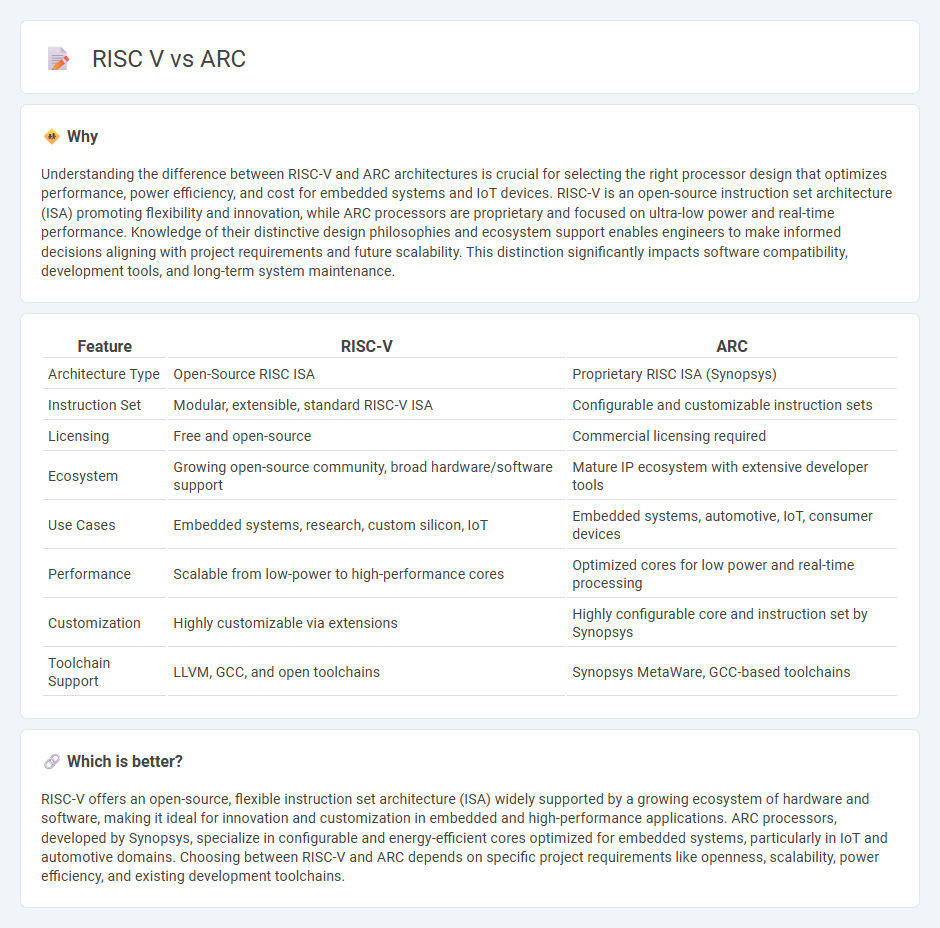
RISC-V and ARC are two prominent open instruction set architectures impacting embedded systems and processor development. RISC-V offers a modular and extensible design widely supported by academia and industry for diverse applications, while ARC focuses on configurable and energy-efficient processors optimized for IoT and real-time computing. Explore the key differences and use cases of RISC-V versus ARC to understand their roles in modern technology.
Why it is important
Understanding the difference between RISC-V and ARC architectures is crucial for selecting the right processor design that optimizes performance, power efficiency, and cost for embedded systems and IoT devices. RISC-V is an open-source instruction set architecture (ISA) promoting flexibility and innovation, while ARC processors are proprietary and focused on ultra-low power and real-time performance. Knowledge of their distinctive design philosophies and ecosystem support enables engineers to make informed decisions aligning with project requirements and future scalability. This distinction significantly impacts software compatibility, development tools, and long-term system maintenance.
Comparison Table
| Feature | RISC-V | ARC |
|---|---|---|
| Architecture Type | Open-Source RISC ISA | Proprietary RISC ISA (Synopsys) |
| Instruction Set | Modular, extensible, standard RISC-V ISA | Configurable and customizable instruction sets |
| Licensing | Free and open-source | Commercial licensing required |
| Ecosystem | Growing open-source community, broad hardware/software support | Mature IP ecosystem with extensive developer tools |
| Use Cases | Embedded systems, research, custom silicon, IoT | Embedded systems, automotive, IoT, consumer devices |
| Performance | Scalable from low-power to high-performance cores | Optimized cores for low power and real-time processing |
| Customization | Highly customizable via extensions | Highly configurable core and instruction set by Synopsys |
| Toolchain Support | LLVM, GCC, and open toolchains | Synopsys MetaWare, GCC-based toolchains |
Which is better?
RISC-V offers an open-source, flexible instruction set architecture (ISA) widely supported by a growing ecosystem of hardware and software, making it ideal for innovation and customization in embedded and high-performance applications. ARC processors, developed by Synopsys, specialize in configurable and energy-efficient cores optimized for embedded systems, particularly in IoT and automotive domains. Choosing between RISC-V and ARC depends on specific project requirements like openness, scalability, power efficiency, and existing development toolchains.
Connection
RISC-V and ARC are connected through their open architectures, enabling customizable and scalable processor designs for embedded systems. Both instruction set architectures focus on energy efficiency and performance optimization in IoT devices, automotive applications, and edge computing. RISC-V's open-source model complements ARC's configurable IP, fostering innovation in diverse semiconductor markets.
Key Terms
Instruction Set Architecture (ISA)
ARC and RISC-V represent distinct Instruction Set Architectures (ISAs) tailored for efficiency and flexibility in embedded systems and processors. ARC ISA, developed by Synopsys, emphasizes customizable and extensible features optimized for specific application needs, while RISC-V provides an open-source, modular ISA design promoting broad adoption and innovation. Explore the detailed comparison to understand which ISA aligns best with your design goals and technical requirements.
Customizability
ARC processors offer extensive customizability with configurable instruction sets and specialized accelerators tailored for embedded and IoT applications, enhancing performance and power efficiency. RISC-V, as an open-source ISA, provides a flexible and extensible architecture that enables developers to design custom extensions and optimize cores for diverse applications across industries. Explore the unique customization features of ARC and RISC-V to determine which architecture best suits your project requirements.
Ecosystem
The ARC architecture offers a mature ecosystem with extensive software development tools, real-time operating system support, and a wide range of IP cores tailored for embedded applications. RISC-V benefits from a rapidly growing open-source community, providing flexible, customizable hardware designs and expanding software libraries that foster innovation across diverse industries. Explore deeper insights into the ARC and RISC-V ecosystems to determine the best fit for your next project.
Source and External Links
Appalachian Regional Commission - ARC is a federal-state partnership that invests in economic development and community capacity in the Appalachian Region through grants, research, and learning programs.
ARC Print Shop - ARC provides digital printing, reprographics, and document workflow solutions with a global presence, focusing on quality, sustainability, and customer service.
Association of Related Churches (ARC) - A cooperative of independent churches that support church planting and pastoral leadership with a mission to see thriving churches reaching communities with the message of Jesus.
 dowidth.com
dowidth.com